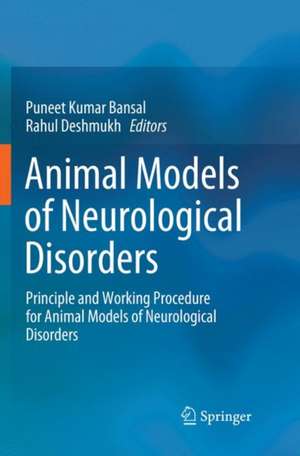Animal Models of Neurological Disorders: Principle and Working Procedure for Animal Models of Neurological Disorders
Editat de Puneet Kumar Bansal, Rahul Deshmukhen Limba Engleză Paperback – 10 dec 2018
| Toate formatele și edițiile | Preț | Express |
|---|---|---|
| Paperback (1) | 788.68 lei 39-44 zile | |
| Springer Nature Singapore – 10 dec 2018 | 788.68 lei 39-44 zile | |
| Hardback (1) | 802.99 lei 39-44 zile | |
| Springer Nature Singapore – 28 ian 2018 | 802.99 lei 39-44 zile |
Preț: 788.68 lei
Preț vechi: 1037.73 lei
-24% Nou
Puncte Express: 1183
Preț estimativ în valută:
150.92€ • 161.38$ • 125.83£
150.92€ • 161.38$ • 125.83£
Carte tipărită la comandă
Livrare economică 14-19 aprilie
Preluare comenzi: 021 569.72.76
Specificații
ISBN-13: 9789811355417
ISBN-10: 981135541X
Pagini: 343
Ilustrații: XVIII, 343 p. 68 illus., 45 illus. in color.
Dimensiuni: 155 x 235 mm
Greutate: 0 kg
Ediția:Softcover reprint of the original 1st ed. 2017
Editura: Springer Nature Singapore
Colecția Springer
Locul publicării:Singapore, Singapore
ISBN-10: 981135541X
Pagini: 343
Ilustrații: XVIII, 343 p. 68 illus., 45 illus. in color.
Dimensiuni: 155 x 235 mm
Greutate: 0 kg
Ediția:Softcover reprint of the original 1st ed. 2017
Editura: Springer Nature Singapore
Colecția Springer
Locul publicării:Singapore, Singapore
Cuprins
Introduction.- Behavioral observation in neurological disorders.- Anesthesia used in experimental laboratory.- Euthanasia procedure used in experimental laboratory.- Animal models of Epilepsy.- Animal models of Alzheimer’s.- Animal models of Parkinson's.- Animal models of Huntington's.- Animal models of Stroke and Traumatic brain injury.- Animal models of Migraine.- Animal models of Antipsychotics (Schizophrenia).
Notă biografică
Dr. Puneet Kumar Bansal is an associate professor of pharmacology at the Department of Pharmaceutical Sciences and Technology, Maharaja Ranjit Singh Punjab Technical University, Bathinda, Punjab, India. Previously, he worked as a professor at the ISF College of Pharmacy, Moga, Punjab. Dr. Bansal completed his Ph.D at the University Institute of Pharmaceutical Sciences, Panjab University, Chandigarh. His research interests encompass the pharmacological screening of herbal and semisynthetic and synthetic drugs in animal models of various diseases such as movement disorders. He has published more than 100 peer-reviewed research papers/book chapters, and has more than 10 years of teaching and research experience. Dr. Bansal completed two major research projects for Government funded agencies. He received the International Brain Research Organization (IBRO) fellowship for attending IBRO neuroscience schools in Hong Kong and Malaysia, and has presented his research work and given invited talks at numerous international conferences. Recently he was selected as Fellow of The Linnean Society of London, which is the world’s oldest active biological society, and is also a member of various highly respected national and international professional societies.
Dr. Rahul Deshmukh is a professor and head of the Department of Pharmacology, ISF College of Pharmacy, Moga, Punjab. He received his doctoral degree from Punjab Technical University, Jalandhar. He has 14 years of teaching and research experience in the field of pharmacology. His research area is focused on understanding the neurobiology of cognitive and movement disorders. He has published over 50 research and review articles in international peer-reviewed journals as well as books and book chapters. He received several research grants from funding agencies of the Government of India. He also delivered various invited talks at a number of conferences and is a member of numerous highly respected national and international professional societies.
Dr. Rahul Deshmukh is a professor and head of the Department of Pharmacology, ISF College of Pharmacy, Moga, Punjab. He received his doctoral degree from Punjab Technical University, Jalandhar. He has 14 years of teaching and research experience in the field of pharmacology. His research area is focused on understanding the neurobiology of cognitive and movement disorders. He has published over 50 research and review articles in international peer-reviewed journals as well as books and book chapters. He received several research grants from funding agencies of the Government of India. He also delivered various invited talks at a number of conferences and is a member of numerous highly respected national and international professional societies.
Textul de pe ultima copertă
This book introduces undergraduate, postgraduate and research students and scientists to animal models of neurological disorders, along with their working principle and brief procedures. Addressing all the disorders related to the central nervous system (CNS) in a single platform, on the basis of various literature surveys it describes different procedures to induce a single disease with the help of toxins/chemicals. It also includes numerous protocols for inducing single neurological diseases, thus fulfilling an urgent need for a book that makes specific procedures for neurological disorders available, so that specific disease can be induced in laboratories according to the availability of resources. Further, it acquaints readers with the pathological changes that occur in a particular neurological disorder, which reflect specific signs and symptoms of any particular disease, and examines how they affect everyday life. It is a valuable resource for researchers aiming to eradicate or improve neurological disorders by testing the benefits of different drugs.
Caracteristici
Introduces undergraduate, postgraduate and research students to the different animal models for studying neurological disorders
Discusses different types of animal models of neurological disorders, the working principle, experimental protocols, different doses of toxins and includes diagrammatical representations
Provides insights into the pathophysiology of neurological disorders
Discusses in detail specific procedures for the induction of neurological disorders so they can be easily reproduced in the laboratory
Discusses different types of animal models of neurological disorders, the working principle, experimental protocols, different doses of toxins and includes diagrammatical representations
Provides insights into the pathophysiology of neurological disorders
Discusses in detail specific procedures for the induction of neurological disorders so they can be easily reproduced in the laboratory
